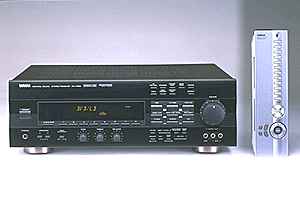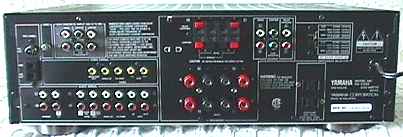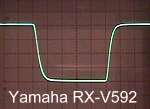J.E. Johnson, Jr.

|
Yamaha RX-V592 Surround Sound Receiver 75 Watts/Channel Front Left/Center/Right, 35 Watts/Channel Rear Left/Right (All Ratings into 8 Ohms) Pro Logic Decoding Full Set of 5.1 RCA Pre-In Jacks (Including Subwoofer), Full Set of 5.1 RCA Pre-Out Jacks Size: 5" H x 17" W x 14 3/4" D Weight: 24 pounds Price: $499 USA
|
|
Yamaha Electronics Corporation, USA, 6660
Orangethorpe Avenue, Buena Park, California 90620-1345 USA; Phone 800-292-2982 |
Many of our readers have written and requested that we review some affordable, yet high quality, receivers. We chose the Yamaha RX-V592 because not only is it inexpensive, but it has a full set of 5.1 pre-in jacks and pre-out jacks so that users can connect decoded 5.1 signals, such as DD and DTS. The 592 has 75 watts each to the front left/center/right and 35 watts each to the rear left/right. Although this is fine for a starter system, the pre-out jacks are immediately available for connection to an outboard five-channel power amplifier. One nice feature here, is that the 5.1 inputs include a subwoofer input that is the 0.1 channel or LFE (Low Frequency Effects) channel input missing from previous receivers.
 The rear of the 592
has the 5.1 pre-ins and pre-outs nicely arranged by themselves
(in the photo, they are the six jacks on the upper left and upper
mid-right of the rear panel). It is almost as if Yamaha expects
you to use them right away, and that is exactly what we did. Besides
the ubiquitous phono preamp inputs, there are audio inputs for
CD, tape (with loop), DVD/LD, TV/DBS, and VCR. Video inputs (coaxial
only, no S-Video) include DVD/LD, TV/DBS, and VCR. There is a
monitor out jack and VCR out jack (coaxial). The speaker terminals
consist of binding posts for the front left and right, while for
the center and rear left/right, spring clips are used. These spring
clips are too small for banana plugs, but bare wire or small spades
will fit. An impedance selector allows using 4 or 8 Ohm speakers,
and the 4 Ohm selection limits voltage so the amplifier won't
go into orbit. Two switched AC outlets are useful for turning
on small components, and we used one of them to trigger an AC
Power Conditioner that turns on a power amplifier and subwoofer
on a timed basis.
The rear of the 592
has the 5.1 pre-ins and pre-outs nicely arranged by themselves
(in the photo, they are the six jacks on the upper left and upper
mid-right of the rear panel). It is almost as if Yamaha expects
you to use them right away, and that is exactly what we did. Besides
the ubiquitous phono preamp inputs, there are audio inputs for
CD, tape (with loop), DVD/LD, TV/DBS, and VCR. Video inputs (coaxial
only, no S-Video) include DVD/LD, TV/DBS, and VCR. There is a
monitor out jack and VCR out jack (coaxial). The speaker terminals
consist of binding posts for the front left and right, while for
the center and rear left/right, spring clips are used. These spring
clips are too small for banana plugs, but bare wire or small spades
will fit. An impedance selector allows using 4 or 8 Ohm speakers,
and the 4 Ohm selection limits voltage so the amplifier won't
go into orbit. Two switched AC outlets are useful for turning
on small components, and we used one of them to trigger an AC
Power Conditioner that turns on a power amplifier and subwoofer
on a timed basis.
 The illuminated remote control
for the 592 is much like the other remotes for the latest Yamaha
receivers, and is very basic, yet allows learning from other remote
controls, and is programmable with macros. You can select the
input, control VCRs and DVD players (circular arranged buttons
at the top left of the remote control photo), select DSP sound
fields (Pro Logic Enhanced, Concert Video, Mono Movie, Stadium,
Disco, Rock, and Hall. When using the 5.1 pre-ins, DSP modes are
not available. The 592 in that case becomes a volume control center
for the DD or DTS analog input signals. Master volume is controlled
with the circular buttons shown at the bottom right of the control
in the photo at the right. You then use the buttons above the
master volume, also arranged in a circle, to adjust center and
rear channel volume. As we have mentioned several times, we prefer
going direct from the video source to the TV, especially with
DVD, where the signal is greatly improved by using the S-Video
output from the player rather than the composite video output.
The illuminated remote control
for the 592 is much like the other remotes for the latest Yamaha
receivers, and is very basic, yet allows learning from other remote
controls, and is programmable with macros. You can select the
input, control VCRs and DVD players (circular arranged buttons
at the top left of the remote control photo), select DSP sound
fields (Pro Logic Enhanced, Concert Video, Mono Movie, Stadium,
Disco, Rock, and Hall. When using the 5.1 pre-ins, DSP modes are
not available. The 592 in that case becomes a volume control center
for the DD or DTS analog input signals. Master volume is controlled
with the circular buttons shown at the bottom right of the control
in the photo at the right. You then use the buttons above the
master volume, also arranged in a circle, to adjust center and
rear channel volume. As we have mentioned several times, we prefer
going direct from the video source to the TV, especially with
DVD, where the signal is greatly improved by using the S-Video
output from the player rather than the composite video output.
The FM/AM tuner has 24 presets for the FM section, and 16 for the AM section. It performs modestly, and is fine for a small system. There is a test tone function, for setting the volume of the various channels. A bass extension button on the front provides + 6 dB at 50 Hz, and the treble and bass controls give ± 10 dB at 20 kHz and 50 Hz, respectively. Although the front channel amplifiers are rated at 75 watts rms, 20 Hz - 20 kHz, 0.04% THD, the center channel is rated at 75 watts rms, 20 Hz - 20 kHz, 0.07% THD, and the rear left/right are 35 watts rms, 1 kHz, 0.3% THD. Thus, the center has slightly less performance than the front left/right, even though they are 75 watts, and the rear is not rated at full spectrum, and so, probably delivers about 25 watts, 20 Hz - 20 Kz. Again however, this is an entry level system.
The front panel display is uncomplicated,
and indicates basic information, such as shown below. For
use with 5.1 inputs, you have to select the DVD/LD input and then
switch to the 6 channel mode (5.1 is actually 6 channels, including
the LFE or subwoofer). None of the DSP sound fields are available
with 5.1, and only the volume control is active (tone controls
active to front channels), but many of the DVD players emerging
now have the ability to adjust several facets of DD sound, and
that should be sufficient in a small system.
For
use with 5.1 inputs, you have to select the DVD/LD input and then
switch to the 6 channel mode (5.1 is actually 6 channels, including
the LFE or subwoofer). None of the DSP sound fields are available
with 5.1, and only the volume control is active (tone controls
active to front channels), but many of the DVD players emerging
now have the ability to adjust several facets of DD sound, and
that should be sufficient in a small system.  When
using a VCR and Pro Logic, the display shows the input and the
fact that Pro Logic is the decoding method.
When
using a VCR and Pro Logic, the display shows the input and the
fact that Pro Logic is the decoding method.
We tested the 592 with a Yamaha DVD-S700 DVD Player, Krix Speakers, and Nordost Cables. The Krix are 8 Ohm loads with modest sensitivity. The sound from the built-in amplifiers is typical of mid-priced mass market products. It is OK as long as you don't turn the volume up very loud. Since this is an entry level receiver, the performance was about as expected (I got 80 dB SPL when using only the front left/right channels, before clipping began to set in). However, the real selling point of the 592 is that it is capable of being connected to outboard 5.1 processors and outboard power amplifiers. We used the 5.1 analog outputs of the DVD-S700 to send decoded DD sound from DVD movies, as well as the analog outputs from a Millennium 5.1 DTS decoder for DTS signals from DTS CDs, and the 592 worked very well for this. When I put in a Carver AV-705x five channel power amplifier, the system really opened up, and I was able to get a great deal more impact to the digital surround sound. In the meantime, the 592 will handle movie sound tracks pretty well, until the time you can afford the more powerful amplifier.
 Square
wave response of the 592 at 10 kHz, ± 10 Volts, shows no
ringing or overshoot. However, the speaker output bandwidth is
limited to 62 kHz (the point at which the sine wave response was
down 3 dB from where it was at 10 kHz). The photo shows the response
through the left speaker output. Bandwidth appears to be a little
higher using the 5.1 pre-outs (69 kHz). DC offset at the speaker
output was - 3.4 millivolts, and very close to 0 using the 5.1
pre-out jacks.
Square
wave response of the 592 at 10 kHz, ± 10 Volts, shows no
ringing or overshoot. However, the speaker output bandwidth is
limited to 62 kHz (the point at which the sine wave response was
down 3 dB from where it was at 10 kHz). The photo shows the response
through the left speaker output. Bandwidth appears to be a little
higher using the 5.1 pre-outs (69 kHz). DC offset at the speaker
output was - 3.4 millivolts, and very close to 0 using the 5.1
pre-out jacks.
In summary, the Yamaha RX-V592 is an attractive receiver for those consumers who want to get into home theater, and who want to be able to upgrade to digital surround later, without setting aside what they already have. The 5.1 pre-ins and 5.1 pre-outs allow connecting any outboard digital decoder as well as any five channel outboard power amplifier for a complete and up-to-date digital surround sound system. It is an uncomplicated, easy to use, and nicely featured unit that is well worth a look.
John E. Johnson, Jr.
© Copyright 1998 Secrets of Home Theater & High Fidelity
Return to Table of Contents for this Issue.

